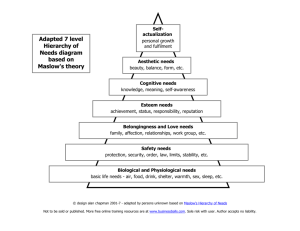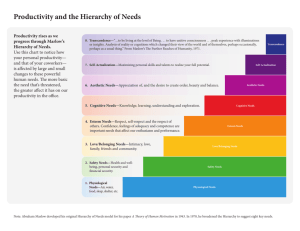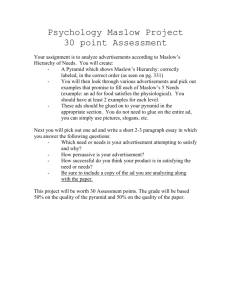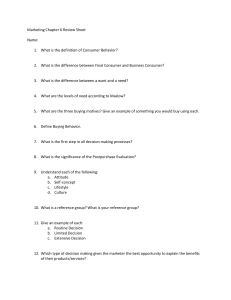Student Assistance 3
advertisement
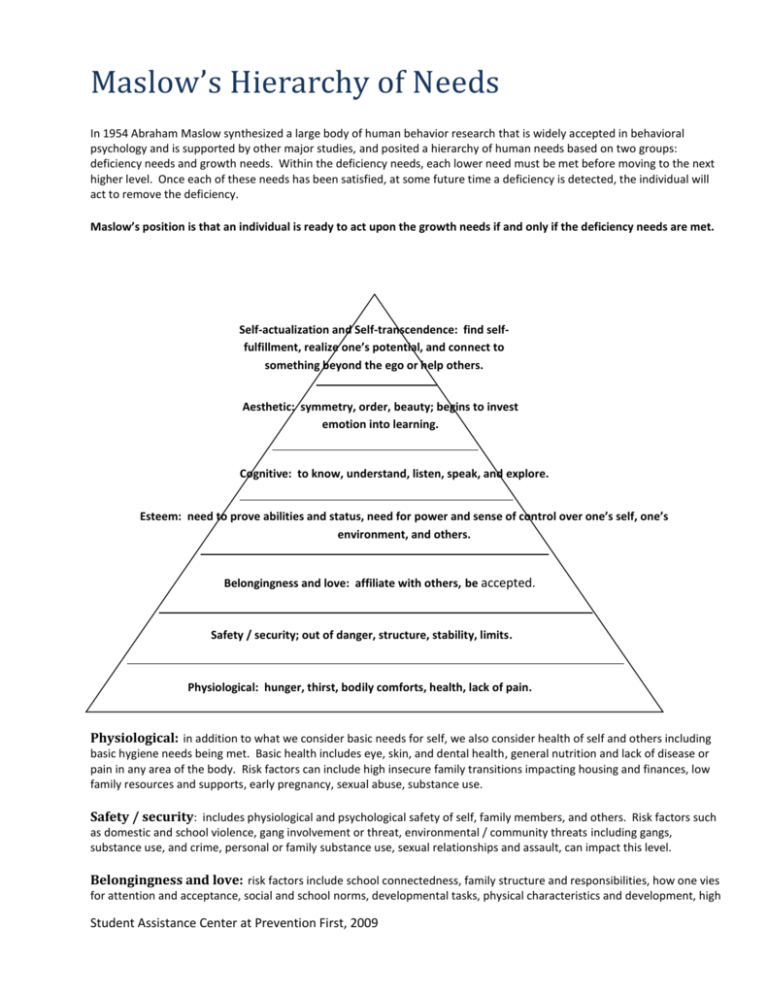
Maslow’s Hierarchy of Needs In 1954 Abraham Maslow synthesized a large body of human behavior research that is widely accepted in behavioral psychology and is supported by other major studies, and posited a hierarchy of human needs based on two groups: deficiency needs and growth needs. Within the deficiency needs, each lower need must be met before moving to the next higher level. Once each of these needs has been satisfied, at some future time a deficiency is detected, the individual will act to remove the deficiency. Maslow’s position is that an individual is ready to act upon the growth needs if and only if the deficiency needs are met. Self-actualization and Self-transcendence: find selffulfillment, realize one’s potential, and connect to something beyond the ego or help others. Aesthetic: symmetry, order, beauty; begins to invest emotion into learning. Cognitive: to know, understand, listen, speak, and explore. Esteem: need to prove abilities and status, need for power and sense of control over one’s self, one’s environment, and others. Belongingness and love: affiliate with others, be accepted. Safety / security; out of danger, structure, stability, limits. Physiological: hunger, thirst, bodily comforts, health, lack of pain. Physiological: in addition to what we consider basic needs for self, we also consider health of self and others including basic hygiene needs being met. Basic health includes eye, skin, and dental health, general nutrition and lack of disease or pain in any area of the body. Risk factors can include high insecure family transitions impacting housing and finances, low family resources and supports, early pregnancy, sexual abuse, substance use. Safety / security: includes physiological and psychological safety of self, family members, and others. Risk factors such as domestic and school violence, gang involvement or threat, environmental / community threats including gangs, substance use, and crime, personal or family substance use, sexual relationships and assault, can impact this level. Belongingness and love: risk factors include school connectedness, family structure and responsibilities, how one vies for attention and acceptance, social and school norms, developmental tasks, physical characteristics and development, high Student Assistance Center at Prevention First, 2009 family transitions and mobility, school/family/peer attitudes toward problem behaviors. Peer group and social exclusion are also strong risk factors. Esteem: Lower order: status, fame, recognition, attention, reputation, appreciation, respect and dominance. Higher order: feelings of confidence, competence, achievement, mastery, independence and freedom. Cognitive: learning new information not sought to fulfill deficiency needs. Learning originating from a need/desire to learn and self-fulfillment rather than seeking information to resolve a deficiency. Aesthetic and Self-Actualization: finding ways to achieve one’s full potential, and connect to purposes higher than self including helping others without gain and helping others achieve their potential. These levels are more typically achieved at the adult life stage. What is especially valuable in the education field is the implication of this research on how people seek information. Norwood (1999), Brazelton, and others affirm that the Maslow Hierarchy informs us about what kinds of information those individuals seek at what levels. Individuals at the lowest levels seek coping information to meet their levels of need. Information that is not connected to helping a person meet his or her needs in a very short time span is simply left unattended. Information must be helping information for the level of need. When physical security and safety, including sleep, are challenged, students will use most of their time, energy, and creativity simply trying to survive. This struggle interferes with learning. Ignoring these needs does not make them go away. Edifying and growth information is sought at the cognitive and above levels, and can be achieved only when the deficiency needs are managed. Schools most often focus on the cognitive level in the educational process. When families, neighborhoods, and schools are safe and healthy, have abundance and students feel accepted by adults and students in culture and gender as well as social acceptance, the cognitive level can have greater outcomes. When conditions exist that demand greater attention on lower levels of deficiency management and fulfillment, student focus at the cognitive level is significantly diminished. Educators cannot assume that children have their physiological, safety, belonging and esteem needs met, and that they are ready to learn simply because they are in school. Data from social service fields tells us that about 10% of all children live in families with abuse and violence, 20% live in families with addiction issues, over 50% live in changing families, and poverty and homelessness are becoming an increasing reality for many families. “Young people do not learn math, reading, or English well if they are intimidated, defensive, and fearful.” D. E. Campbell, The Work of Abraham Maslow, Pearson Allyn Bacon Prentice Hall Dr. C. George Boreree "Abraham Maslow, Personality Theories Psychology - The Search for Understanding, by Janet A. Simons, Donald B. Irwin and Beverly A. Drinnien West Publishing Company, New York, 1987 Franken, R. (2001) Human motivation (5th ed.)., Pacific Grove, CA: Brooks/Cole. Maslow’s hierarchy of needs. Retrieved from the internet July 1, 2009 at http://chiron.valdosta.edu Nohria, N., Lawrence, P., & Wilson, E. (2001). Driven: How human nature shapes our choices. San Francisco: Jossey-Bass. Thompson, M. Grace, C. & Cohen, L. (2001) Best friends, worst enemies: Understanding the social lives of children. New York: Ballantine Books. W. Huitt Maslow's Hierarchy of Needs, Educational Psychology Interactive Valdosta, Ga. Student Assistance Center at Prevention First, 2009


